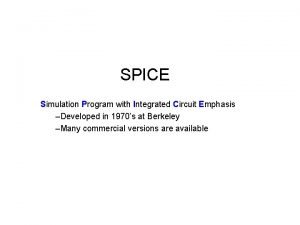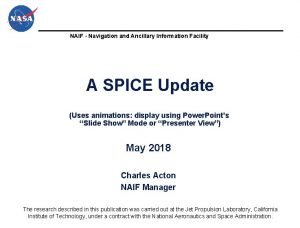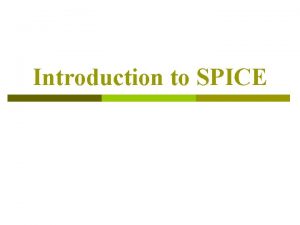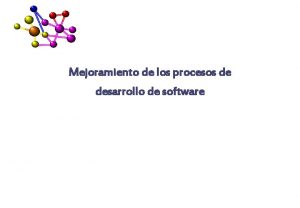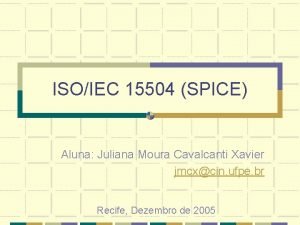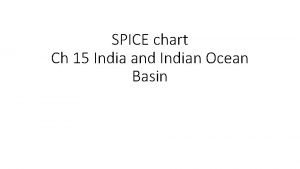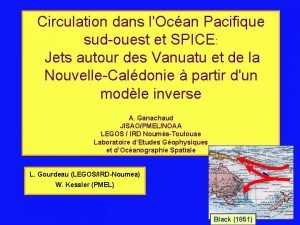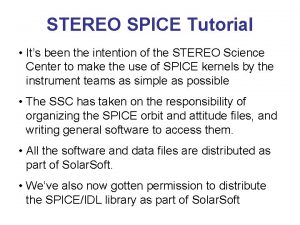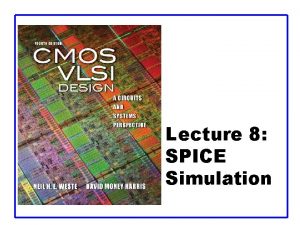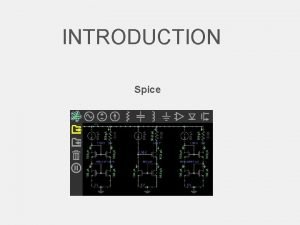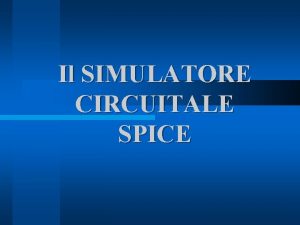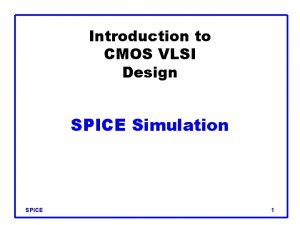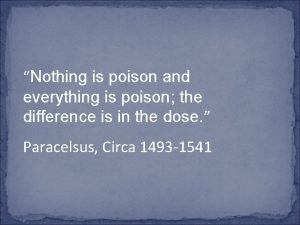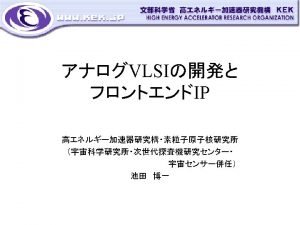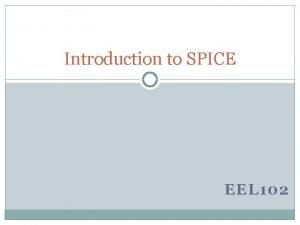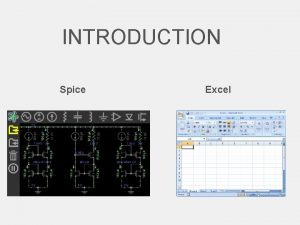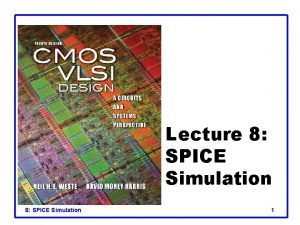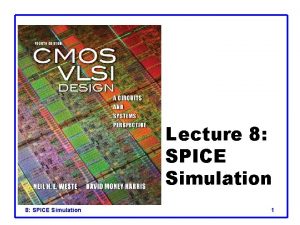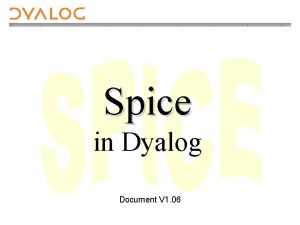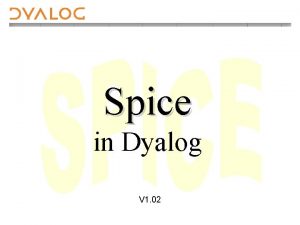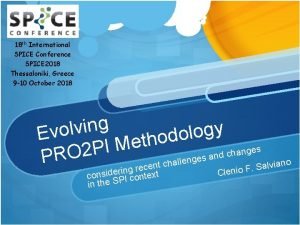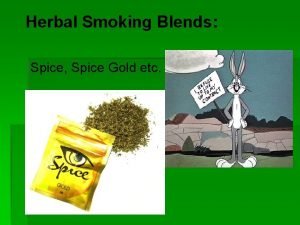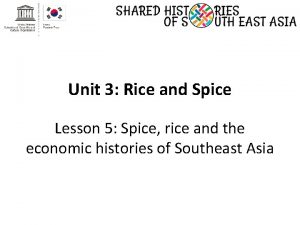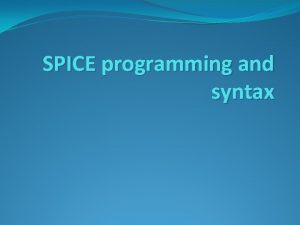Lecture 8 SPICE Simulation 1 Outline q q



























- Slides: 27

Lecture 8: SPICE Simulation 1

Outline q q q q Introduction to SPICE DC Analysis Transient Analysis Subcircuits Optimization Power Measurement Logical Effort Characterization 8: SPICE Simulation CMOS VLSI Design 4 th Ed. 2

Introduction to SPICE q Simulation Program with Integrated Circuit Emphasis – Developed in 1970’s at Berkeley – Many commercial versions are available – HSPICE is a robust industry standard • Has many enhancements that we will use q Written in FORTRAN for punch-card machines – Circuits elements are called cards – Complete description is called a SPICE deck 8: SPICE Simulation CMOS VLSI Design 4 th Ed. 3

Writing Spice Decks q Writing a SPICE deck is like writing a good program – Plan: sketch schematic on paper or in editor • Modify existing decks whenever possible – Code: strive for clarity • Start with name, email, date, purpose • Generously comment – Test: • Predict what results should be • Compare with actual • Garbage In, Garbage Out! 8: SPICE Simulation CMOS VLSI Design 4 th Ed. 4

Example: RC Circuit * rc. sp * David_Harris@hmc. edu 2/2/03 * Find the response of RC circuit to rising input *------------------------* Parameters and models *------------------------. option post *------------------------* Simulation netlist *------------------------Vin in gnd pwl 0 ps 0 100 ps 0 150 ps 1. 0 1 ns 1. 0 R 1 in out 2 k C 1 out gnd 100 f *------------------------* Stimulus *------------------------. tran 20 ps 1 ns. plot v(in) v(out). end 8: SPICE Simulation CMOS VLSI Design 4 th Ed. 5

Result (Graphical) 8: SPICE Simulation CMOS VLSI Design 4 th Ed. 6

Sources q DC Source Vdd vdd gnd 2. 5 q Piecewise Linear Source Vin in gnd pwl 0 ps 0 100 ps 0 150 ps 1. 0 1 ns 1. 0 q Pulsed Source Vck clk gnd PULSE 0 1. 0 0 ps 100 ps 300 ps 8: SPICE Simulation CMOS VLSI Design 4 th Ed. 7

SPICE Elements Letter R C L K V I M D Q W X E G H F Element Resistor Capacitor Inductor Mutual Inductor Independent voltage source Independent current source MOSFET Diode Bipolar transistor Lossy transmission line Subcircuit Voltage-controlled voltage source Voltage-controlled current source Current-controlled voltage source Current-controlled current source 8: SPICE Simulation CMOS VLSI Design 4 th Ed. 8

Units Letter Unit Magnitude a atto 10 -18 f fempto 10 -15 p pico 10 -12 n nano 10 -9 u micro 10 -6 m milli 10 -3 k kilo 103 x mega 106 g giga 109 Ex: 100 femptofarad capacitor = 100 f. F, 100 f, 100 e-15 8: SPICE Simulation CMOS VLSI Design 4 th Ed. 9

DC Analysis * mosiv. sp *------------------------* Parameters and models *------------------------. include '. . /models/ibm 065/models. sp'. temp 70. option post *------------------------ * Simulation netlist *------------------------*nmos Vgs g gnd 0 Vds d gnd 0 M 1 d g gnd NMOS W=100 n L=50 n *------------------------* Stimulus *------------------------. dc Vds 0 1. 0 0. 05 SWEEP Vgs 0 1. 0 0. 2. end 8: SPICE Simulation CMOS VLSI Design 4 th Ed. 10

I-V Characteristics q n. MOS I-V – Vgs dependence – Saturation 8: SPICE Simulation CMOS VLSI Design 4 th Ed. 11

MOSFET Elements M element for MOSFET Mname drain gate source body type + W=<width> L=<length> + AS=<area source> AD = <area drain> + PS=<perimeter source> PD=<perimeter drain> 8: SPICE Simulation CMOS VLSI Design 4 th Ed. 12

Transient Analysis * inv. sp * Parameters and models *------------------------. param SUPPLY=1. 0. option scale=25 n. include '. . /models/ibm 065/models. sp'. temp 70. option post * Simulation netlist *------------------------Vdd vdd gnd 'SUPPLY' Vin a gnd PULSE 0 'SUPPLY' 50 ps 0 ps 100 ps 200 ps M 1 y a gnd NMOS W=4 L=2 + AS=20 PS=18 AD=20 PD=18 M 2 y a vdd PMOS W=8 L=2 + AS=40 PS=26 AD=40 PD=26 * Stimulus *------------------------. tran 0. 1 ps 80 ps. end 8: SPICE Simulation CMOS VLSI Design 4 th Ed. 13

Transient Results q Unloaded inverter – Overshoot – Very fast edges 8: SPICE Simulation CMOS VLSI Design 4 th Ed. 14

Subcircuits q Declare common elements as subcircuits. subckt inv a y N=4 P=8 M 1 y a gnd NMOS W='N' L=2 + AS='N*5' PS='2*N+10' AD='N*5' PD='2*N+10' M 2 y a vdd PMOS W='P' L=2 + AS='P*5' PS='2*P+10' AD='P*5' PD='2*P+10'. ends q Ex: Fanout-of-4 Inverter Delay – Reuse inv – Shaping – Loading 8: SPICE Simulation CMOS VLSI Design 4 th Ed. 15

FO 4 Inverter Delay * fo 4. sp * Parameters and models *-----------------------------------. param SUPPLY=1. 0. param H=4. option scale=25 n. include '. . /models/ibm 065/models. sp'. temp 70. option post * Subcircuits *-----------------------------------. global vdd gnd. include '. . /lib/inv. sp' * Simulation netlist *-----------------------------------Vdd vdd gnd 'SUPPLY' Vin a gnd PULSE 0 'SUPPLY' 0 ps 20 ps 120 ps 280 ps X 1 a b inv * shape input waveform X 2 b c inv M='H' * reshape input waveform 8: SPICE Simulation CMOS VLSI Design 4 th Ed. 16

FO 4 Inverter Delay Cont. X 3 X 4 x 5 c d e f inv inv M='H**2' * device under test M='H**3' * load M='H**4' * load on load * Stimulus *-----------------------------------. tran 0. 1 ps 280 ps. measure tpdr * rising prop delay + TRIG v(c) VAL='SUPPLY/2' FALL=1 + TARG v(d) VAL='SUPPLY/2' RISE=1. measure tpdf * falling prop delay + TRIG v(c) VAL='SUPPLY/2' RISE=1 + TARG v(d) VAL='SUPPLY/2' FALL=1 . measure tpd param='(tpdr+tpdf)/2' * average prop delay. measure trise * rise time + TRIG v(d) VAL='0. 2*SUPPLY' RISE=1 + TARG v(d) VAL='0. 8*SUPPLY' RISE=1. measure tfall * fall time + TRIG v(d) VAL='0. 8*SUPPLY' FALL=1 + TARG v(d) VAL='0. 2*SUPPLY' FALL=1. end 8: SPICE Simulation CMOS VLSI Design 4 th Ed. 17

FO 4 Results 8: SPICE Simulation CMOS VLSI Design 4 th Ed. 18

Optimization q HSPICE can automatically adjust parameters – Seek value that optimizes some measurement q Example: Best P/N ratio – We’ve assumed 2: 1 gives equal rise/fall delays – But we see rise is actually slower than fall – What P/N ratio gives equal delays? q Strategies – (1) run a bunch of sims with different P size – (2) let HSPICE optimizer do it for us 8: SPICE Simulation CMOS VLSI Design 4 th Ed. 19

P/N Optimization * fo 4 opt. sp * Parameters and models *-----------------------------------. param SUPPLY=1. 0. option scale=25 n. include '. . /models/ibm 065/models. sp'. temp 70. option post * Subcircuits *-----------------------------------. global vdd gnd. include '. . /lib/inv. sp' * Simulation netlist *-----------------------------------Vdd vdd gnd 'SUPPLY' Vin a gnd PULSE 0 'SUPPLY' 0 ps 20 ps 120 ps 280 ps X 1 a b inv P='P 1' * shape input waveform X 2 b c inv P='P 1' M=4 * reshape input X 3 c d inv P='P 1' M=16 * device under test 8: SPICE Simulation CMOS VLSI Design 4 th Ed. 20

P/N Optimization X 4 X 5 d e e f inv P='P 1' M=64 M=256 * load on load * Optimization setup *-----------------------------------. param P 1=optrange(8, 4, 16) * search from 4 to 16, guess 8. model optmod opt itropt=30 * maximum of 30 iterations. measure bestratio param='P 1/4' * compute best P/N ratio * Stimulus *-----------------------------------. tran 0. 1 ps 280 ps SWEEP OPTIMIZE=optrange RESULTS=diff MODEL=optmod. measure tpdr * rising propagation delay + TRIG v(c)VAL='SUPPLY/2' FALL=1 + TARG v(d) VAL='SUPPLY/2' RISE=1. measure tpdf * falling propagation delay + TRIG v(c) VAL='SUPPLY/2' RISE=1 + TARG v(d) VAL='SUPPLY/2' FALL=1 . measure tpd param='(tpdr+tpdf)/2' goal=0 * average prop delay. measure diff param='tpdr-tpdf' goal = 0 * diff between delays. end 8: SPICE Simulation CMOS VLSI Design 4 th Ed. 21

P/N Results q P/N ratio for equal delay is 2. 9: 1 – tpd = tpdr = tpdf = 17. 9 ps (slower than 2: 1 ratio) – Big p. MOS transistors waste power too – Seldom design for exactly equal delays q What ratio gives lowest average delay? . tran 1 ps 1000 ps SWEEP OPTIMIZE=optrange RESULTS=tpd MODEL=optmod – P/N ratio of 1. 8: 1 – tpdr = 18. 8 ps, tpdf = 15. 2 ps, tpd = 17. 0 ps q P/N ratios of 1. 5: 1 – 2. 2: 1 gives tpd < 17. 2 ps 8: SPICE Simulation CMOS VLSI Design 4 th Ed. 22

Power Measurement q HSPICE can measure power – Instantaneous P(t) – Or average P over some interval. print P(vdd). measure pwr AVG P(vdd) FROM=0 ns TO=10 ns q Power in single gate – Connect to separate VDD supply – Be careful about input power 8: SPICE Simulation CMOS VLSI Design 4 th Ed. 23

Logical Effort q Logical effort can be measured from simulation – As with FO 4 inverter, shape input, load output 8: SPICE Simulation CMOS VLSI Design 4 th Ed. 24

Logical Effort Plots q Plot tpd vs. h – Normalize by t – y-intercept is parasitic delay – Slope is logical effort q Delay fits straight line very well in any process as long as input slope is consistent 8: SPICE Simulation CMOS VLSI Design 4 th Ed. 25

Logical Effort Data q For NAND gates in IBM 65 nm process: q Notes: – Parasitic delay is greater for outer input – Average logical effort is better than estimated 8: SPICE Simulation CMOS VLSI Design 4 th Ed. 26

Comparison 8: SPICE Simulation CMOS VLSI Design 4 th Ed. 27
 Spice simulation
Spice simulation Spice (simulation program with integrated circuit emphasis)
Spice (simulation program with integrated circuit emphasis) 01:640:244 lecture notes - lecture 15: plat, idah, farad
01:640:244 lecture notes - lecture 15: plat, idah, farad Lecture outline meaning
Lecture outline meaning Lecture outline example
Lecture outline example Lecture outline example
Lecture outline example Lecture outline example
Lecture outline example Sentence outline example
Sentence outline example Sui tang song dynasties
Sui tang song dynasties The rice n spice international ltd
The rice n spice international ltd Naif spice
Naif spice Schneider electric my learning link
Schneider electric my learning link Spice stands for
Spice stands for Capacity maturity model
Capacity maturity model Modelo spice
Modelo spice Chartch
Chartch Old spice case study
Old spice case study Spice jets
Spice jets Spice tutorial
Spice tutorial Life 120 cosa mangiare
Life 120 cosa mangiare In spice letter q represents vlsi
In spice letter q represents vlsi Languagen
Languagen Cmmi niveles
Cmmi niveles Difference between spice and herbs
Difference between spice and herbs Spice computer program
Spice computer program Simulatore spice
Simulatore spice Q letter is used in spice for modeling
Q letter is used in spice for modeling Pumpkin spice communion wafers
Pumpkin spice communion wafers

